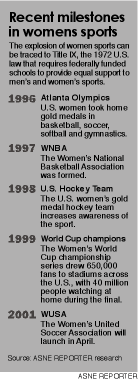|
|
|
HOME TODAY PHOTOS SCHEDULE ARCHIVES STAFF SITES WWW.ASNE.ORG |
|
|
Women's sports coverage still lacking
Blame it on the women. At the 1996 Summer Olympic Games in Atlanta, the U.S. women's basketball, soccer, softball and gymnastics teams brought home gold and set the stage for what's considered an explosion in women's sports.
Since "The Year of the Woman," as it was widely known, there has been a boom in women's sports coverage , from the 1997 launch of the Women's National Basketball Association to the 1998 U.S. women's gold -medal hockey team to the 1999 Women's World Cup champion U.S. team. April 2001 will see the arrival of the Women's United Soccer Association. Despite such overwhelming popularity, very few reporting beats were created to cover professional women's sports teams and women's sports in general. This lack of coverage was the central topic among the female sports journalists and athletes on a panel Thursday afternoon. Newspapers continue to lag behind coverage on television and the Internet. "The sports world is changing, and we're barely reflecting this," said Christine Brennan, sports columnist for USA Today and best-selling author of books on ice skating. "There is no excuse for this." During the weekend of Feb. 12-13 this year, three sports events fought for television ratings. Tiger Woods was going for his seventh consecutive golf tournament victory at the Buick Invitational, the National Basketball Association was stagingAll-Star weekend and Michelle Kwan was favored to win the U.S. Figure Skating Championship. Kwan won, but despite being a native of Los Angeles and a student at UCLA, her feat was reported on page 13 of the Los Angeles Times sports section. "Why do I see figure skating all the time on TV and don't see it on the front pages of sports sections?" Brennan asked. "TV ratings are a measure of the popularity of the program, and newspapers do not reflect this." Just six years earlier, the Tonya Harding-Nancy Kerrigan Winter Olympics rivalry brought figure skating to the forefront of the sports world. CBS' coverage of the 1994 Short Program in figure skating received a 48.5 ratings share, the sixth highest-rated program ever. The only other sporting events with better ratings were Super Bowls XVI and XVII. Despite the overwhelming increase in interest, no figure skating beats were created. Niche publications were created to fill the void. "The explosion in women sports happened five years ago, but we're still waiting for coverage of this explosion," said Sandy Bailey, editor of Sports Illustrated for Women, which launched last month. Much of the reason for the expansion of women's sports involves Title IX, the 1972 law that requires federally funded institutions give equal support to men's and women's sports. An example of Title IX influence occurred during last year's Women's World Cup, which brought more than 650,000 fans to stadiums across the United States during the tournament's 32 matches, with 40 million fans watching at home during the final. Many of the team's players — including Mia Hamm, the world's most prolific female soccer scorer with 106 career goals — were born about the time the law was passed. "They are the personification of Title IX," Brennan said. "People don't see how enjoyable this form of entertainment can be," said Whitney Smith, who covers the Tennessee Lady Vols basketball team for The (Nashville) Tennesseean. "The women's game doesn't have the flash of the above-the-rim game seen in men's basketball, but women should be allowed to display their talent." Many female sports writers say editors who oversee their work tend not to cover women's athletics because the majority of their readers are businessmen, who have only recently shown any interest in these stories. "With newspaper sizes getting smaller and others folding, it's a gamble to try something new," said Amy Shipley, Olympics sports beat writer for The Washington Post. "People cover what they are used to watching." Susan Bischoff, deputy managing editor of the Houston Chronicle, says newspapers can't afford to ignore women's sports. "What many editors don't realize is that girls are interested in sports, and if they can't read about the WNBA or the U.S. women's soccer team in the newspaper, they'll find that information on the Web or elsewhere. In a time of dwindling circulation, newspapers cannot lose these potential readers." Subsequently, many female sports reporters either change sections or leave journalism altogether. "Frustration, not the family, is the culprit," Bailey said. Meanwhile several professional female athletes are upset that newspapers treat their leagues as second-class by sending either interns, rookie or disinterested reporters out to cover their events. "I can't tell you the amount of times when I had to go to a press conference and work to get [reporters] excited," said professional golfer Meg Mallon. "One time, a reporter told me that I was lucky that their paper was covering our golf event and that I better give them something to write about." Cynthia Cooper, two-time most valuable player and three-time WNBA champion with the Houston Comets, said she is confused with teammate Sheryl Swoops during interviews. "I'm tired of being Sheryl, " Cooper said. "Some journalists just don't care. They don't do their homework, and with the Internet it's so easy to find out about WNBA players." |
|
|


